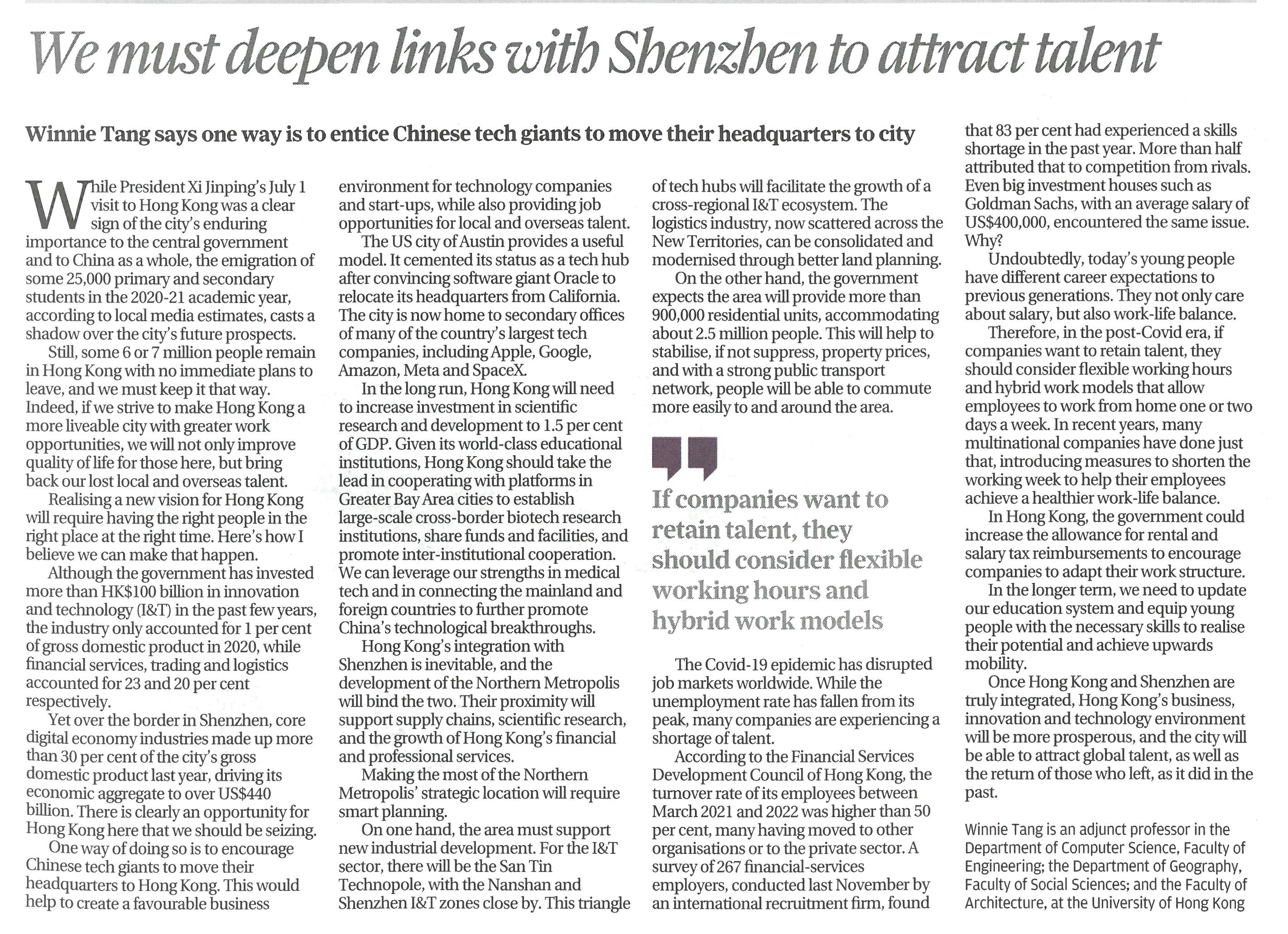網上版請按此

We must deepen links with Shenzhen to attract talent
While President Xi Jinping's July 1 visit to Hong Kong was a clear sign of the city's enduring importance to the central government and to China as a whole, the emigration of some 25,000 primary and secondary students in the 2020/21 academic year, according to local media estimates, casts a shadow over Hong Kong's future prospects.
Still, some 6 or 7 million people remain in Hong Kong with no immediate plans to leave, and we must keep it that way. Indeed, if we strive to make Hong Kong a more liveable city with greater work opportunities, we will not only improve quality of life for those already here, but bring back our lost local and overseas talent.
Realising a new vision for Hong Kong will require having the right people in the right place at the right time. Here's how I believe we can make that happen.
Although the government has invested more than HK$100 billion in innovation and technology (I&T) in the past few years, the industry only accounted for 1 per cent of gross domestic product in 2020, while financial services, trading and logistics accounted for 23 and 20 per cent respectively.
Yet over the border in Shenzhen, core digital economy industries made up more than 30 per cent of the city's gross domestic product last year, driving its economic aggregate to over US$440 billion. There is clearly an opportunity for Hong Kong here that we should be seizing.
One expedient way of doing so is to encourage Chinese tech giants to move their headquarters to Hong Kong. This would help to create a favourable business environment for technology companies and start-ups, while also providing new employment opportunities for local and overseas talent.
The US city of Austin provides a useful model. It cemented its status as a tech hub after convincing software giant Oracle to relocate its headquarters from California. The city is now home to secondary offices of many of the country's largest tech companies, including Apple, Google, Amazon, Meta and SpaceX.
In the long run, however, Hong Kong will need to increase investment in scientific research and development to 1.5 per cent of GDP. Given its world-class educational institutions, Hong Kong should take the lead in cooperating with platforms in Greater Bay Area cities to establish large-scale cross-border biotech research institutions, share funds and facilities, and promote inter-institutional cooperation. We can also leverage our strengths in medical tech and in connecting China and foreign countries to further promote China's technological breakthroughs in frontier fields.
Hong Kong's integration with Shenzhen is inevitable, and the development of the Northern Metropolis will bind the two. Their proximity will support supply chains, scientific research, and the growth of Hong Kong's financial and professional services.
Making the most of the Northern Metropolis' strategic location will require smart planning.
On one hand, the area must support new industrial development. For the I&T sector, there will be the San Tin Technopole, with the Nanshan and Shenzhen I&T zones close by. This triangle of tech hubs will facilitate the growth of a cross-regional I&T ecosystem. In addition, the logistics industry, currently scattered across the New Territories, can be consolidated and modernised through improved land planning.
On the other hand, the government expects that the area will provide more than 900,000 residential units, accommodating about 2.5 million people. This will help to stabilise, if not suppress, property prices, and with a strong public transport network, people will be able to commute more easily to and around the area.
The Covid-19 epidemic has disrupted job markets worldwide. While the unemployment rate has fallen from its peak, many companies are experiencing a shortage of talent.
According to the Financial Services Development Council of Hong Kong, the turnover rate of its employees between March 2021 and 2022 was higher than 50 per cent, many having moved to other organisations or to the private sector. A survey of 267 financial-services employers, conducted last November by an international recruitment firm, found that 83 per cent had experienced a skills shortage in the past year. More than half attributed that to competition from rivals. Even big investment houses such as Goldman Sachs, with an average salary of US$400,000, encountered the same issue. Why?
Undoubtedly, today's young people have different career expectations to previous generations. They not only care about salary, but also work-life balance.
Therefore, in the post-Covid era, if companies want to retain talent, they should consider flexible working hours and hybrid work models that allow employees to work from home one or two days a week. In recent years, many multinational companies have done just that, introducing measures to shorten the working week to help their employees achieve a healthier work-life balance.
Here in Hong Kong, the government could increase the allowance for rental and salary tax reimbursements to encourage companies to adapt their work structure.
In the longer term, we need to update our education system and equip young people with the necessary skills to realise their potential and achieve upward mobility.
Once Hong Kong and Shenzhen are truly integrated, Hong Kong's business, innovation and technology environment will be more prosperous, and the city will be able to attract global talent, as well as the return of those who left, as it did in the past.
Dr. Winnie Tang
Adjunct Professor, Department of Computer Science, Faculty of Engineering; Department of Geography, Faculty of Social Sciences; and Faculty of Architecture, The University of Hong Kong